Directive Illocutionary Act Used by The Main Character in “The End of the F***ing World”
on

p-ISSN: 2528-5076, e-ISSN: 2302-920X
Terakreditasi Sinta-3, SK No: 105/E/KPT/2022 Vol 28.1. Pebruari 2024: 110-121
Directive Illocutionary Act Used by The Main Character in “The End of the F***ing World”
I Dewa Gede Bagus Prabawa, I Putu Andri Permana Mahasaraswati Denpasar University, Denpasar, Bali. Indonesia Correspondence email: dewaprabawa31@gmail.com, andripermana@unmas.ac.id
Article Info
Submitted: 21st August 2023
Revised: 19th November 2023
Accepted: 21st December 2023
Publish: 29th February 2024
Keywords: directive; illocutionary act; utterance; main character
Corresponding Author: I
Dewa Gede Bagus Prabawa email:
DOI:
https://doi.org/10.24843/JH.20
24.v28.i01.p10
Abstract
The purpose of this study is to analyzedirective illocutionary act, spesifically about how action can occur only with the use of language spoken by the main characters in The End of the F***ing World series.Theory by Halliday and Hasan (1985) was applied to analyse the situational context which refers to the place, topic of the conversation, participants’s relationship, and how language is used in the conversation. There is also theory by Yule (1996) about the explanation of action that performed just by utterance called directive illocutionary act and divided into command, order, request and suggestion. This study used a descriptive qualitative method... The results found all types of directive illocutionary act used by the main characters in their daily life to make someone do something, where the success rate in using directive illocutionary act is related with the situational context.. This study used formal and informal methods in its presentation.
INTRODUCTION
Language is a structured communication tool that consists of grammar and vocabulary that is used by humans to communicate. Verderber, (1999) defined language as the collection of words and the structure for their use in communication that is shared by the individuals of the same community, nation, or geographical area, or with similar cultures and traditions. Language is a non-instinctive and wholly human method of conveying ideas, feelings and desires using a system of symbols generated spontaneously (Sapir, 1921). Human uses language in order to connect and communicate with each other. Kreidler (1998) also stated language is creativity, our communications are not limited to static themes, we create and interpret new messages based on new things including contexts and experiences. Lestari et al. (2017) states that communication refers to social interaction. Moreover, Davis (1997) defined communication as the method of exchanging data or information and understanding from one individual to another. Since ancient times, the global community has utilized language to communicate, express themselves and interact with other members of society. There are many ways in creating good communication. Some of them are by knowing the context, learning pragmatics, and using speech acts.
Context refers to the information that surrounds an event, and it is directly connected to its meaning (Hall & Hall, 1990). In communication, context becomes an important part of conversation which can make messages and responses more focused and reduce misunderstandings of meaning. According to Leech (1983), pragmatics is a study that learns about meaning that is related to speech situations. Furthermore, Levinson (1983) defined pragmatics is the study of the capacity of language users to associate sentences with the context in which they would be suitable. A speech act is one aspect of pragmatics. Based on Yule (1996) a speech act refers to an action carried out by the listener in response to the speaker's speech. It means that an utterance can be used to do things and not only used to describe or inform things. People utilise the action of speaking to express emotions that potentially have an intention (Putri, Maharani, & Utami, 2022). Three types of speech acts exist. The first is a locutionary act which means the act of stating anything and using specific terms, well-formed from a syntactic perspective and meaningful. The second is an illocutionary act which means the action performed by someone via utterance, and the last is a perlocutionary act which means the effect or the consequences on the audience or the hearer through the utterance (Austin, 1962).
To influence the listeners or audience to give their actions as a part of their contribution to the conversation is the role of the illocutionary act (Sudiyono et al., 2023). Assertives, directives, commissives, expressive, and declarations are the types of illocutionary acts (Searle, 1979). Assertive means stating or telling something factual. Directives are speech acts that try to get the hearer to do something. Commissives state a commitment of the speaker set his or her future course of action. Expressives are expressions of feelings and attitudes towards existing conditions. The last one is declaration, which means announcing something that could change the world. From those types of illocutionary acts, the main focus of this study and the commonly used for ordering someone to do something is directive illocutionary. This research was supported by several papers divided into two theses and four articles concerning the analysis of directive illocutionary acts.
The first research was conducted by Puranjani & Rajeg (2022). entitled Directive Illocutionary Acts of the Characters’ Utterances in “The Desperate Hour” Movie. The researcher concentrated on characterize the sorts of utterances of directives illocutionary acts and the illocutionary forces of the characters' utterances in "The Desperate Hour" movie.. Their study and this study investigate the same topic which is directive illocutionary acts, The difference lies in the purpose and source of the data. Puranjani & Rajeg’s analysis was centred on types of directive illocutionary act and the illocutionary forces of the characters. Puranjani & Rajeg’s study used data obtained from a film while this study focused on the context of the situation, and the data were taken from a TV series.
Furthermore, it is followed by the second research by Putra & Sedeng (2022) entitled Directive Illocutionary Acts Found in the Movies 21 And 22 Jump Street. Putra & Sedeng’s study aimed to identify the classification and the force of directive illocutionary acts. The method used was the similarity between their study and this study, while they differed in their purpose. Putra & Sedeng’s study focused on the direct and indirect directive illocutionary act, while this study focused on the types and situational context.
The third is an article written by Jayantha, Maharani, & Permana (2022), entitled An Analysis of Directive Illocutionary Act Found in Movie “Hobbs & Shaw” by David Leitch. The focus of this study was to determine the types of directive illocutionary acts
and analyse the contextual situations. The purpose of both this study and Jayantha's was to identify the types and circumstances of directive illocutionary acts, and to employ similar methodologies and theories. The difference lies in the data sources used. Jayantha's study used a movie as its source of data, whereas this study used a TV series.
Yardha & Ambalegin (2022) wrote the article titled “Directive Speech Act in Cruella 2021 Movie”. This study aimed to determine the types of directive speech acts in the movie, Cruella in 2021. This study used a qualitative approach to analyse directive speech acts. Both studies aimed to identify the types of directive illocutionary acts and employed a qualitative approach, albeit using different theories. Yardha used the theory by Searle (1979) for his study while this study applied the theory proposed by Yule (1996) to identify the types of directive illocutionary acts.
The fifth article was written by Tamang, Putri, & Ariyaningsih (2021) entitled Directive Illocutionary Acts in Best Health Podcast Entitled Talking to Your Kids About Coronavirus (Covid-19). The objective of this study is to identify the types of directive illocutionary acts in Best Health Podcast and to determine their frequency. The data of this study were taken from the utterance produced by Best Health and Dr. Linda Nicoletti in the Best Health Podcast entitled Talking to your kids about Coronavirus (COVID-19). There are two similarities between his research and ours. Firstly, his research aimed to identify the various kinds of directive illocutionary acts. Secondly, he employed a descriptive qualitative approach to analyse the data. On the other hand, our study differs from his in two ways. Firstly, their research used a podcast as the data source, whereas ours relied on a television series. Secondly, their purpose was to describe the occurrence of directive illocutionary acts, whereas ours aims to gain insight into the contextual factors.
The last research was taken from Oktaviani, Syafitri, & Syafrizal (2021) entitled Directive Illocutionary Acts in Me Before You Movie. The researcher utilised quantitative and qualitative methods to analyse the data, with a film being used as the source of data while this study used a qualitative method only and used a TV series as a data source. To conclude, the film Me Before You included various types of illocutionary acts.
Knowing what is on someone's mind when they uttered something is one way to figure out what they are trying to say and know how to respond appropriately by learning directive illocutionary acts based on TV series that related to real-life phenomena and the context of the situation.
METHOD AND THEORY
Several concrete procedures must be followed in conducting this study to ensure an authentic outcome. These include selecting the appropriate data source, data collection technique, data analysis method, and data presentation technique for presenting the results.
In this study, the data were taken from “The End of the F***ing World” TV series. “The 'The End of The F***ing World'”television series was released in 2017. The series is based on a comic by Charles S. Forsman and directed by Jonathan Entwistle and Lucy Tcherniak in its first season. “The End of the F***ing World” was published on 24 October 2017 and divided into 8 episodes for the first season. This series narrates a tale of James (Alex Lawther), a 17-year-old teenager who believes himself to be a psychopath. He then befriends Alyssa (Jessica Barden), a girl who enjoys adventure and has father-related issues, and who is a sociopath. They go on an unlucky journey and face some criminal cases in this drama-comedy series.
Observational method was employed to gather data for the study, following a series of steps. The steps of collecting the data were watching the whole episodes of “The End of the F***ing World” series in the first season to understand the storyline, taking note of all the utterances that were categorized as directive illocutionary acts. Finally, the data was classified based on the theory by Halliday & Hasan (1985) to analyze the situational context that refers to the topic and place of the conversation, the relationship between participants and also the language that used in the conversation. While the theory proposed by Yule (1996) to examine the directive illocutionary act to make someone do something with various types of directive illocutionary acts. The study's findings were presented in two formats. The first was a formal method that presents the data in a table to show the frequency of each directive illocutionary act type used and the second is an informal method to know the data clearly by using bold typing and italics with a descriptive explanation using sentences in the paragraph supported by the theory of context of situation proposed by Halliday & Hasan (1985).
RESULT AND DISCUSSION
This chapter discusses the results and findings obtained from the data source of the series entitled “The End of the F***ing World” series. The outcomes include all types of directive illocutionary acts, namely, command, order, request, also suggestion.
Table 1. Directive illocutionary act types used by the main characters.
|
No |
Types |
Amount |
Percentage |
|
1. |
Command |
2 |
25% |
|
2. |
Order |
2 |
25% |
|
3. |
Request |
2 |
25% |
|
4. |
Suggestion |
2 |
25% |
|
Total |
8 |
100% |
The presented table displays the outcomes of each type of directive illocutionary act identified in the first season of “The End of the F***ing World” series. All types of directive illocutionary acts were used in the series, according to the theory presented by Yule (1996), as shown in the table above.
The main characters in the series employ directive illocutionary acts to instruct other individuals to act directly or indirectly, based on the situational context.
A command is an action that provides instructions to someone to perform a certain task. Commands are efficient when the speaker has some level of authority over the recipient's behaviour. Commands can be created with different levels of clarity (Kreidler, 1998).
Based on the picture 1, there are two people in the frame name Alyssa and James, they are as a friend at the same school. The conversation took place when James and Alyssa were in the car to leave the town. Alyssa then asked James to take off his clothes with the condition that James was still driving and he found it difficult to take off his clothes. James finally suggested to stop but Alyssa refused. In that conversation, Alyssa
answered James' questions using language that was relatively polite and firm. The utterance spoken by Alyssa is a contradiction to James through the sentence "No." which shows disapproval and then continues with the utterance "Keep driving." which is categorized as a Command for James to keep driving the car while removing his clothes.
Data 1
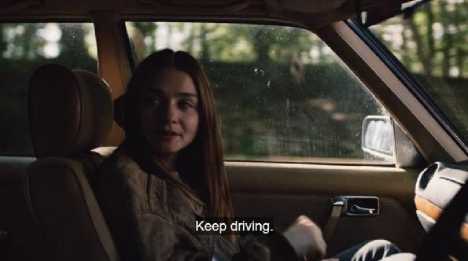
Picture. 1
(Episode 2, 04:50 - 04:56)
James: Should… Should we stop?
Alyssa: No. Keep driving.
The command directive illocutionary act uttered by Alyssa in the data above was classified successfully because James' response after hearing the statement was just obeying and continuing to do what Alyssa wants. James' timid personality made him believe that Alyssa is his close friend. It is why he followed Alyssa's instructions to take off his clothes while driving the car.
Data 2
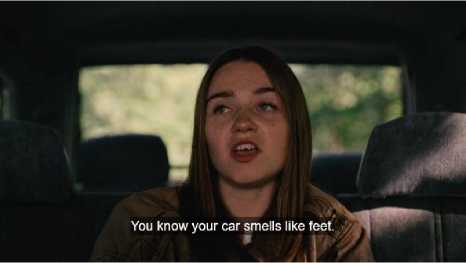
Picture. 2 (Episode 2, 09:17 - :09:31)
Army vet: Number 23 on the Top 25 Most Dangerous Dog List, for fighting.
James: They expensive?
Army vet: Just a bit.
Alyssa: You know your car smells like feet.
The data above shows a picture with a conversation consisting of three participants, namely James, Alyssa, and an army veteran. When James' car was damaged when it crashed into a tree, he and Alyssa were forced to hitch a ride with an army veteran who received them on the side of the road. James and Alyssa's relationship is as a friend while the army veteran is a stranger to James and Alyssa. During the conversation between James and the army veteran about a photo of a dog inside a car, suddenly Alyssa said "You know your car smells like feet". Alyssa used informal language, which may be considered impolite, while speaking to people she had just met. The utterance is categorized as a Command which has a hidden meaning and indirectly commands the army vet to clean his car because it smells like feet.
The command directive illocutionary act uttered by Alyssa was classified as an unsuccessful category due to the response from the army vet who only looked at her and laughed he thought that Alyssa was a stranger he had just met and he should not have to follow Alyssa's words, who incidentally was a stranger to him.
An order is a type of directive illocutionary act, which serves the purpose of making the listener do something for the speaker directly, and is always carried out (Kreidler, 1998).
Data 3

Picture. 3
(Episode 2, 13:55 - 00:14:06)
Alyssa: Where you think you’re going?
Army vet: Well I… gotta go. The dog not gonna collect herself, now is she?
Alyssa: Gimme your wallet.
Army vet: You what?
Alyssa: Give me your wallet.
Based on the picture 3, there is a utterance that contained directive illocutionary act. The picture consists of participants nameAlyssa, James, and an Army vet. In the bathroom, Alyssa found that James experienced sexual harassment from an army vet they were traveling with. The relationship between them is stranger for the Army vet, while Alyssa and James as a friend. At that time, this Army vet tried to run away after doing sexually harassment to James but Alyssa stopped and told him to give his wallet by saying “Gimme your wallet”. Hearing this, the Army vet asked again and said "You what?" with a confused expression. Alyssa, who was fed up, answered emphatically
"Give me your wallet". In the conversation, Alyssa uses informal and formal language. Informal language can be seen from the word "Gimme" which stands for “Give me”, then the second utterance used the formal language “Give me“. The use of informal and formal language helps Alyssa in giving orders, when the informal language she utters is ignored, she uses formal language to reinforce her orders. The sentences uttered by Alyssa in the data above “Gimme your wallet” and “Give me your wallet” are categorized as an Order. This is because Alyssa asked the army veteran to do something directly for her, which is to give away his wallet.
The order directive illocutionary act that Alyssa spoke when she found out about the Army veteran's sexual harassment of James saying “What are you doing?” and “Where do you think you're going”' to depress him was categorised as successful due to her spoken utterances. Finally, he did what Alyssa said and handed over his wallet, and then the Army veteran left James and Alyssa.
Data 4

Picture. 4
(Episode 6, 15:04 - 15:14)
*Alyssa and her mom on the phone*
Gwen: What's happened, Alyssa? Where are you? Are you with your dad?
Alyssa: No.
Gwen: Come home, Alyssa.
Alyssa: Tell Tony I said, “Fuck off.”
The picture 4 consist of a data where directive illocutionary was used. The conversation consisting of 2 participants, namely Alyssa and Gwen. Alyssa and Gwen's relationship are a daughter and a mother. This conversation took place when Alyssa had left her house, she then intended to meet her biological father. On the journey, she saw a payphone on the side of the road and called her mother. Hearing Alyssa's voice, her mother picked and asked where she was and told her to go home, but the answer given by Alyssa was “Tell Tony I said, “Fuck off!”. Alyssa used informal language while talking to her mother, and her utterance also included elements of disgusted swearing with the phrase "Fuck off". This utterance belongs to the Order type. The reason is that Alyssa asked her mother to do something for her directly, to give a message to Tony (Alyssa's adoptive father) that she was disgusted with Tony’s behavior.
The order directive illocutionary act that Alyssa uttered to her mother was classified as an unsuccessful category, that because her mother's response was silent. It is also because Gwen's personality and fear of Tony made her ignore messages from Alyssa to
Tony and always pretended that their relationship was fine when Alyssa was still at home.
A request refers to the expression of what the speaker desires the addressee to either do or abstain from doing. A request aims to solicit something from the listener in a specific situation with an utterance that is less demanding and polite (Kreidler, 1998).
Data 5

Picture. 5
(Episode 2, 00:58 - 01:06)
Alyssa: Guess what freedom smells like?
James: What?
Alyssa: Cow shit.
James: Seat belt.
Alyssa: Fuck seat belts.
It can be seen from the picture 5 there are two participants doing a conversation. The conversation of the data above took place on a street after James punched his father in the face and stole his car. James and Alyssa left using the car and intended to leave town. James and Alyssa's relationship is a schoolmate. On the way, James said “Seat Belt” to Alyssa because they were driving a car. The utterance spoken by James "Seat Belt" is a Request type of directive illocutionary act. This sentence is categorized as a request type because the expression James said was polite and less demanding when he asked Alyssa to do something, namely to use a seat belt in the car. James used informal language when he said this to his friend, Alyssa.This is because James only said "Seat belt" without containing anything else or providing safety guidelines when driving a car.
The request directive illocutionary that James said belongs to the unsuccessful category. When hearing James’s utterance, Alyssa's face looked like she did not care about James' words, and said “Fuck seat belts”.
The conversation of the picture 6 occurred when the car driven by James was on the street and then hit a tree when he was about to leave town. The participants in the conversation are James and Alyssa as a friend. When the accident happened, James looked very panicked, while Alyssa, on the other hand, laughed when the car driven by James hit a tree. This made James wonder. The informal language used by James at that time was "Why are you laughing?" because in the context of that utterance, James was talking to a friend and that utterance was categorized as a Request. The sentence "Why
are you laughing?" uttered by James had a hidden meaning in the form of a request to Alyssa to stop laughing because James crashed her father's favorite car.
Data 6
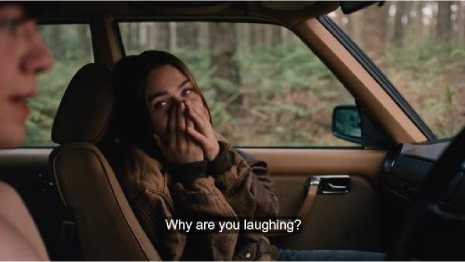
Picture. 6
(Episode 2, 05:24 - 05:31)
*Car crashes and Alyssa laughs*
James: Why are you laughing?
James: My dad loves this car. It's the most expensive thing he's ever bought.
The request directive illocutionary act spoken by James to Alyssa in the data above was included in the successful category. This was due to James's personality who is usually very calm and quiet looked very panicked during that incident. Seeing James panicked made Alyssa who kept laughing turns into realizing that things were getting serious.
Suggestions are the statements we provide to others to indicate our opinions as to their desired or undesired actions. (Kreidler, 1998).
Data 7
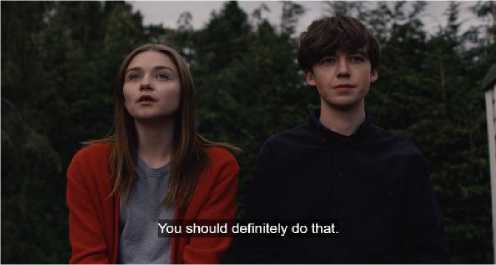
Picture. 7
(Episode 1, 11:11 - 11:22)
Alyssa: Your dad's a prick.
James: Yeah, I know. Sometimes, I feel like punching him in the face.
Alyssa: You should definitely do that.
Based on the picture 7, there is a conversation consisting of two participants name James and Alyssa. They are both friends who attend the same school. When Alyssa was at James' house, she met Phil. Phil is James' father. Alyssa felt a little annoyed because Phil seemed like a person who did not believe in his son because he thought James was weird and thought that James was gay, but he felt relieved because James brought a girl to the house. Alyssa and James were conversing while sitting on the swing in the yard. Alyssa made a remark about her father being a scumbag and James agreed, mentioning that he too sometimes felt an urge to punch his father in the face. Then Alyssa uttered “You should definitely do that” to James. The utterance spoken by Alyssa used informal language where she was talking to someone whose context is a friend. Alyssa's words are categorized as a suggestion. The reason for this is because of the use of the word "Should" which contains her opinion about what action James should do in the future, which is to punch Phil's face.
When Alyssa uttered that, James's response was just a faint smile without saying anything as if he was still thinking about doing it. Therefore, the suggestion directive illocutionary act that Alyssa uttered to James was classified in the unsuccessful category.
Data 8
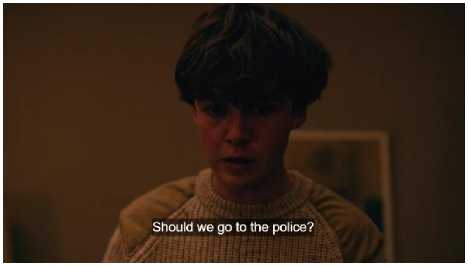
Picture. 8 (Episode 6, 01:01 - 01:10)
James: Sorry.
Alyssa: It’s OK.
James: Should we go to the police?
Alyssa: What?
James: It was self-defense.
From the picture and data 8, the participants in the conversation are James and Alyssa. They both are schoolmates. The conversation took place when James and Alyssa were staying at an empty house owned by a professor. When Alyssa was sleeping on the bed while James was right under the bed with a knife to kill Alyssa because of his mind that he was a psychopath. Unexpectedly, the house owner attempted to rape and harm Alyssa.James swiftly stabbed the professor in the neck with a knife. When they knew that the professor was dead James asked Alyssa and suggested if they should go to the police station to report it or not. The statement “Should we go to the police?” uttered by James was included in the suggestion category where he used the word "should" which refers to suggestions about reporting the case to the police. James uses informal language in the context of asking about his friend's opinion of Alyssa about what action they should take in the future after killing the professor.
The suggestion directive illocutionary act failed or unsuccesful, considering Alyssa's reaction of 'What?' which showed her surprise and disapproval. Alyssa was aware that the police would not trust her as far as the self-defense aspect is concerned.
CONCLUSION
The study found four types of directive illocutionary that were implemented in the series entitled “The End of the F***ing World” Season 1. Command, order, request, and suggestion are the types found in this series. From all of the data, the main characters of “The End of the F***ing World” series used directive illocutionary act to express what they want and make the listener do something, directly or indirectly. The effectiveness of using directive illocutionary act is also related to the situational context, the characteristics, and the background of the main characters.
Further research is suggested to explore the effects of directive illocutionary acts on the physiological system of humans.
REFERENCES
Austin, J. L. (1962). How to do Things with Words. Great Britain: Oxford University Press.
Davis, K. (1997). Human Behavior at Work: Organizational Behavior. New York: McGraw-Hill, Inc.
Hall, E. I., & Hall, M. R. (1990). Understanding Cultural Differences: Germans, French and Americans. USA: Intercultural Press.
Halliday, M. A. K., & Hasan, R. (1985). Language, Context, and Text: Aspects of Language in a Social – Semiotic. Victoria: Deakin University Press.
Jayantha, I. K. R. D., Maharani, P. D., & Permana, I. P. A. (2022). Command Directive Illocutionary Act Found in “Hobbs & Shaw” Movie. ELYSIAN JOURNAL: English Literature, Linguistics and Translation Studies, Vol. 2, No. 3, 64–76.
Kreidler, C. W. (1998). Introducing English Semantics. New York: Routledge.
Leech, G. N. (1983). Principles of Pragmatics. London: Longman.
Lestari, D., Suastra, I. M., Pastika, I. W., & Sedeng, I. N. (2017). Developing A Method of Learning English Speaking Skills Based on the Language Functions Used in the Food and Beverage Service. E-Journal of Linguistics, Vol. 11, No. 1, 70–79.
Levinson, S. C. (1983). Pragmatics. New York: Cambridge University Press.
Oktaviani, A., Syafitri, D., & Syafrizal, S. (2021). Directive Illocutionary Acts in Me Before You Movie. Linguistic, English Education and Art (LEEA) Journal, Vol. 4, No. 2, 457–462.
Putri, N. L. N., Maharani, P. D., & Utami, N. M. V. (2022). Directive Illocutionary Act: The Command Occurs in The Characters of Jungle Cruise Movie. ELYSIAN JOURNAL: English Literature, Linguistics and Translation Studies, Vol. 2, No. 3, 97–106.
Putra, I. P .W. A., & Sedeng, I.N. (2022). Directive Illocutionary Acts Found in the Movies 21 and 22 Jump Street. HUMANIS: Journal of Arts and Humanities, Vol. 26, No. 2, 180-187.
Puranjani, N. W. A. N., & Rajeg, I. M. (2022). Directive Illocutionary Acts of the Characters' Utterances in "The Desperate Hour" Movie. HUMANIS: Journal of Arts and Humanities, Vol. 26, No. 4, 321-328.
Sapir, E. (1921). Language. An Introduction to the Study of Speech. New York: Harcourt, Brace.
Searle, J. R. (1979). Expression and Meaning: Studies the Theory of Speech Acts. USA: Cambridge University Press.
Sudiyono, B. A. T., Candra, K. D. P., & Putri, I. G. A. V. W. (2023). Illocutionary Acts in Spider-Man: No Way Home. ELYSIAN JOURNAL: English Literature, Linguistics and Translation Studies, Vol. 3, No. 2, 21–30.
Tamang, M. T. P. P., Putri, I. G. A. V. W., & Ariyaningsih, N. N. D. (2021). Directive Illocutionary Acts in Best Health Podcast Entitled Talking to Your Kids About Coronavirus (Covid-19). ELYSIAN JOURNAL: English Literature, Linguistics and Translation Studies, Vol. 1, No.2, 37–46.
Verderber, R. F. (1999). Speech For Effective Communication. New York: Holt, Rinehart and Winston.
Yardha, F. S., & Ambalegin, A. (2022). Directive Speech Act in Cruella 2021 Movie. Humanitatis: Journal of Language and Literature, Vol. 9, No.1, 25–38.
Yule, G. (1996). Pragmatics. Hong Kong: Oxford University Press.
Discussion and feedback